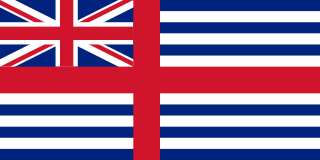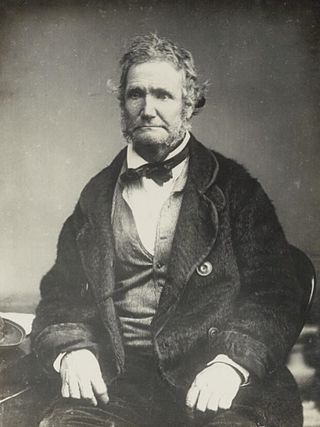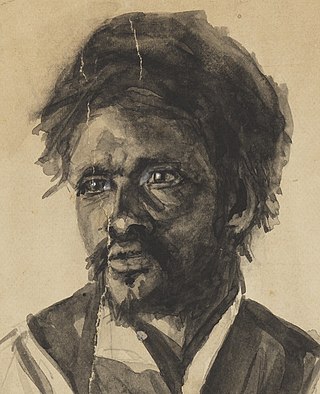
Van Diemen's Land was the colonial name of the island of Tasmania used by the British during the European exploration and colonisation of Australia in the 19th century. The island, inhabited by Aborigines, was first encountered by the Dutch ship captained by Abel Tasman in 1642, working under the sponsorship of Anthony van Diemen, the Governor-General of the Dutch East Indies. The British retained the name when they established a settlement in 1803 before it became a separate colony in 1825. Its penal colonies became notorious destinations for the transportation of convicts due to the harsh environment, isolation and reputation for being inescapable.

Bushrangers were armed robbers and outlaws who resided in the Australian bush between the 1780s and the early 20th century. The original use of the term dates back to the early years of the British colonisation of Australia, and applied to transported convicts who had escaped into the bush to hide from the authorities. By the 1820s, the term had evolved to refer to those who took up "robbery under arms" as a way of life, using the bush as their base.
The history of Tasmania begins at the end of the Last Glacial Period when it is believed that the island was joined to the Australian mainland. Little is known of the human history of the island until the British colonisation of Tasmania in the 19th century.

The Macquarie Harbour Penal Station, a former British colonial penal settlement, established on Sarah Island, Macquarie Harbour, in the former colony of Van Diemen's Land, now Tasmania, operated between 1822 and 1833. The settlement housed male convicts, with a small number of women housed on a nearby island. During its 11 years of operation, the penal colony achieved a reputation as one of the harshest penal settlements in the Australian colonies. The former penal station is located on the eight-hectare (twenty-acre) Sarah Island that now operates as a historic site under the direction of the Tasmania Parks and Wildlife Service.

Thomas Bock was an English-Australian artist and an early adopter of photography in Australia. Born in England he was sentenced to transportation in 1823. After gaining his freedom he set himself up as one of Australia's first professional artists and became well known for his portraits of colonists. As early as 1843 he began taking daguerreotypes in Hobart and became one of the earliest commercial photographers in Australia.

Martin Cash was a notorious Irish-Australian convict bushranger, known for escaping twice from Port Arthur, Van Diemen's Land. His 1870 autobiography, The Adventures of Martin Cash, ghostwritten by James Lester Burke, also a former convict, became a best seller in Australia.

William Sorell was a soldier and third Lieutenant-Governor of Van Diemen's Land.

Sir John Eardley Eardley-Wilmot, 1st Baronet was a politician in the United Kingdom who served as Member of Parliament (MP) for North Warwickshire and then as Lieutenant-Governor of Van Diemen's Land.

Musquito was an Indigenous Australian resistance leader, convict hunter and outlaw based firstly in the Sydney region of the British colony of New South Wales and, after a period in exile on Norfolk Island, in Van Diemen's Land.

Robert Knopwood was an early clergyman and diarist in Australia.
Sir John Lewes Pedder was an English Australian judge, politician and grazier, he was the first Chief Justice of Van Diemen's Land.
Michael Howe was a British convict who became a notorious bushranger and gang leader in Van Diemen's Land, Australia.
David Burn was a Tasmanian pioneer and dramatist, author of the first Australian drama to be performed on stage, The Bushrangers. He has been called Australia's first playwright.
The Lieutenant Governor's Court was a court established in the early 19th century in the colony of Van Diemen's Land which subsequently became Tasmania, a state of Australia. The court had jurisdiction to deal with civil disputes where the amount in dispute was not more than £50 sterling in the colony. The establishment of the court was the first practical civil court in the settlement. This was an important first step in improving the resolution of civil disputes in the settlement. The Supreme Court of Van Diemen's Land eventually replaced it in 1823 when the court's charter was revoked by the Third Charter of Justice.
Andrew Bent was a printer, publisher and newspaper proprietor, active in Australia. He established the first successful newspaper in Tasmania, was the first Australian newspaperman to print a newspaper free from government control, and the first Australian printer to be imprisoned for libel.
Henry James Emmett (1782–1848) was an English born public servant. He was in the War Office in England for seven years before emigrating to Van Diemen's Land in 1819 where he filled a number of roles in government. He and his family travelled on the Regalia a private merchant ship, arriving on 30 November 1819.
Henry Saxelby Melville Wintle, commonly referred to as Henry Melville, was an Australian journalist, author, occultist, and Freemason best remembered for writing the play The Bushrangers, his historical work The History of Van Diemen's Land From the Year 1824 to 1835, and his occult philosophical work Veritas: Revelation of Mysteries, Biblical, Historical, and Social by Means of the Median and Persian Laws. His life was dramatized in the 1882 Princess Theatre (Bendigo) production Found, or Found Drowned.
D'Arcy Wentworth, born Dorset Crowley, was a New South Wales army captain, police magistrate and politician.

Francis Burgess (1793–1864) was an English barrister, the first police commissioner for Birmingham, England, and subsequently chief police magistrate of Van Diemen's Land, and served as a Member of the Van Diemen's Land Legislative Council.
Van Dieman's Land is a 1830 British musical comedy play by William Thomas Moncrieff. It was set in Tasmania and concerned the bushranger Michael Howe.










